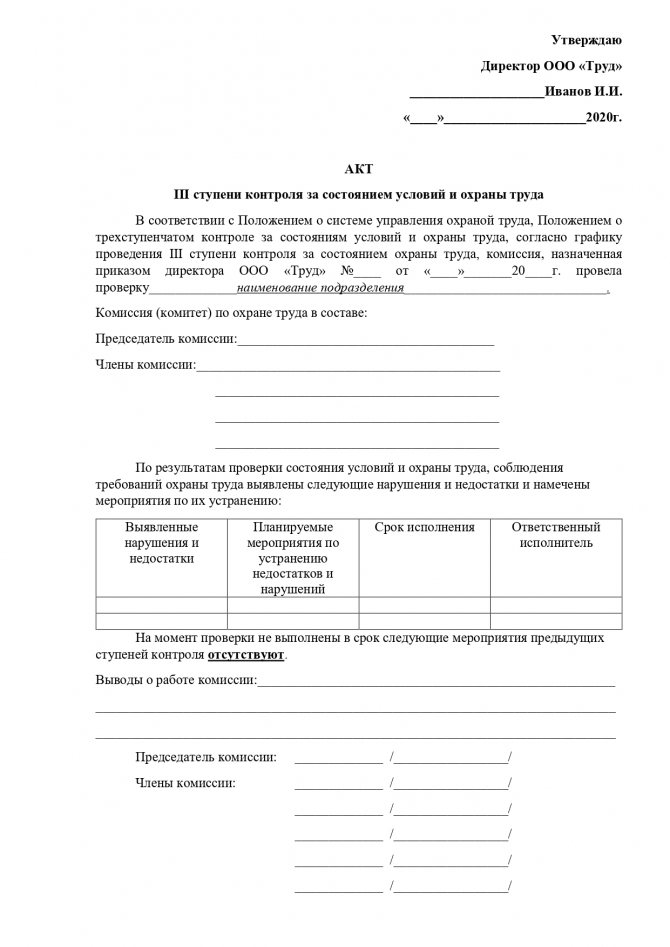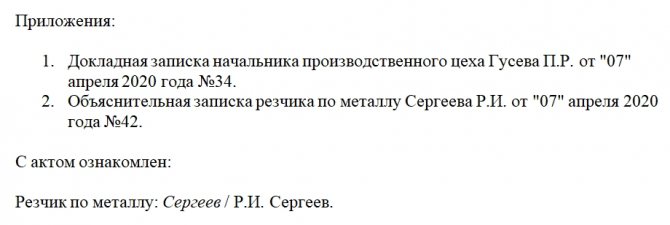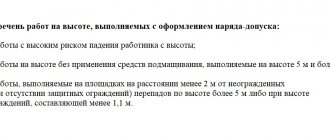Ensuring labor protection at the enterprise
The head of the company has a statutory obligation to ensure that inspections are carried out of the implementation of labor protection measures at the enterprise entrusted to him.
In particular, Article 212 of the Labor Code of the Russian Federation states that the boss’s responsibilities include ensuring control over the implementation of safety requirements at employees’ workplaces.
Supervision of compliance with these standards must satisfy the following requirements:
- It should be as effective as possible, not performed formally, but done to identify problems and solve them in a timely manner.
- The objectivity of studying the situation at the enterprise is important. Professional specialists may be involved in the assessment, taking into account the study of all facts that are relevant to labor protection.
- Systematic inspections mean that they must cover all parts of the enterprise and be carried out on a regular basis.
- An important feature of effective control is its timeliness. It is important to detect shortcomings at a time when there is an opportunity to correct them.
The Federal Labor Inspectorate monitors compliance with safety regulations.
Article 370 of the Labor Code of the Russian Federation provides that the trade union organization is given the right to control how the administration fulfills the conditions specified in the employment contracts of employees and, in particular, those related to compliance with safety rules.
I will develop documents for you
Enter your phone number and I will calculate an estimate for your tasks. Enter without the eight. “Bureau of Ekaterina Vorontsova” – a full range of services for labor protection, civil defense and emergency situations. High quality and on time!
Regulations on three-stage control
The regulation reveals in detail the entire sequence of conducting an audit in a particular organization, establishes the structure, and assigns the duties and responsibilities of each level. It is worth providing information on the main measures and control parameters.
As a rule, responsibility for developing regulations falls on the shoulders of a labor protection specialist; production workers who know the work of their department well can be involved as experts. If there is a trade union, then coordination with this body is required, because the rights of workers must be taken into account.
The regulation on three-stage labor protection control is approved by the head of the organization, and you can click on the link for a sample.
Order on three-stage labor protection control
The next main document is an order on three-stage labor protection control, which can be free-form. The main thing is that it reflects the composition of the commission (committee), which checks at 3 levels of control.
The composition can include diverse employees, not necessarily only management, it can vary from director to blue-collar professions. In this case, the inspection will be carried out more efficiently, because an employee who is constantly at work can know and notice some shortcomings that reduce safety and bring them to the attention of the entire commission.
The chairman, of course, should be the employer or his deputy, it can also be the chief engineer, it all depends on the hierarchy of your organization. The ideal option is when the members of the commission include employees who:
- competent in labor safety issues;
- have extensive work experience in this organization;
- interested in conducting full control.
The composition of the commission (committee) for conducting three-stage control should be odd, it could be 3 people, or you might want to include 7 employees. I leave you an order to conduct a three-stage control, which you can download by following the link.
Journal of three-stage labor protection control
The next stage of analysis and preparation of documents is a log of three-stage labor protection control, which is necessary to record violations at stages 1 and 2; for stage 3 in some organizations the results are also documented in a log, and in others only in an act, but more on that later .
The frequency of filling out the journal determines the position that you have developed, and in addition to the shortcomings, you need to record the activities that need to be carried out by the person in charge.
A separate journal is kept for each division and its form can be determined individually. You can download a sample log of three-stage labor protection control by clicking on the link.
If, based on the regulation, only self-control is allowed at the 1st level of control, then if violations are detected, the employee must report the detected shortcomings to his immediate supervisor.
Act of three-stage control on labor protection
The act of three-stage control on labor protection prepares the 3rd stage of control. This form can be developed by you yourself, but, in fact, it may look like an order from an occupational safety specialist.
The act must summarize and record all identified violations in a specific area, determine the measures that must be taken to eliminate them, assign responsible persons and deadlines for implementation. I leave a three-stage labor protection control act, a sample of which you can find here.

The procedure for conducting inspections of various industries
There are different types of supervision:
- Technical - refers to the material side of production. At the same time, objects of labor and production conditions are checked.
- Social is a method of control designed to assess the work activity of the enterprise’s employees.
You can also classify according to who may be the initiator of such checks:
- Departmental control method - carried out at the direction of a higher organization. In this case, control activities can be regular, systematic, or can be carried out in accordance with an official request for verification activities.
- Public control over compliance with safety regulations - the initiator of inspections in this case is usually the trade union organization at the enterprise, which acts in the interests or at the request of employees.
Internal review
Constant internal control consists of daily self-examination by the employee of his workplace. He monitors the serviceability of the technical equipment used, the condition of existing protective fences in hazardous areas, the condition of workers’ overalls, the cleanliness and order of work areas, and the serviceability of existing fire extinguishing equipment.
The level of operational control includes those activities that are carried out by department heads together with representatives of trade unions or work collectives. In this case, the compliance of the work performed is checked with existing instructions on the protection and safe performance of work, the implementation of measures to control production processes, the degree of safety of equipment and tools, compliance with the relevant instructions when performing work with fire or explosive materials, and the sanitary condition of the premises.
Some of them are carried out as random controls. In this case, a commission works, which necessarily includes a labor protection engineer and a representative of a higher organization. The subject, usually, is the availability of personal protective equipment and knowledge of the procedure for their use by employees, compliance by the management of the enterprise with the regulatory requirements of the Labor Code of the Russian Federation, implementation of the necessary safety measures, certification of employee workplaces and other issues related to labor protection.
State control
Such inspections are divided into scheduled and unscheduled. In the first case, the State Labor Inspectorate compiles a list with a calendar sequence, in accordance with which the implementation of safety rules in organizations is monitored.
Law No. 294-FZ of December 16, 2008 (“On the protection of rights... during state control”) states that such events cannot be carried out more than once every three years. In practice, these regulatory authorities are heavily loaded with work and it may well be that inspections will take place much less frequently.
Unscheduled events are usually carried out based on complaints from company employees. The inspection is regulated by Law No. 294-FZ.
The duration cannot be more than 20 working days. If during work there is a need for additional examinations or lengthy research, by decision of the head of the labor inspectorate, the work period may be extended by an additional 20 working days.
The subject of control is compliance with the provisions of labor legislation. In some cases, events can be carried out thematically and cover specific areas of the enterprise:
- compliance with employment contracts;
- salary;
- issues related to the provision of vacations;
- other questions.
In this case, first of all, they analyze:
- collective agreement;
- labor contracts;
- internal rules of the company;
- other local regulations of the company.
The following discusses in detail the implementation of labor protection requirements.
Briefly about the employer's procedure
If the employee did not comply with the labor safety requirements, then the first step is to write a report. It must record the circumstances of the violation and its consequences. It is written by the immediate superior of the offender addressed to the head of the company.
Next, the management, after familiarizing itself with the contents of the report, issues an order to create a special commission (at least 3 people). Sometimes an occupational safety committee already exists at the enterprise. Its task is internal control of compliance with occupational safety rules. In this case, the commission must identify all the details of the violation, record them, interviewing witnesses and the violator himself.
The result of such activity should be an act establishing a violation of occupational safety requirements in the organization. Based on this paper, the offending employee must be subject to disciplinary action (possibly dismissal).
Important! If an employee refuses to sign an act of violation, then another document is drawn up - this is an act of refusal to sign the act.
Registration of inspection results
Based on the results of the control, a report must be drawn up. In addition, for specific facts of violations, orders may be issued with a requirement to correct the problems within a specific period provided.
Form and rules for filling out the inspection report
The act is drawn up in two copies and signed by all members of the commission. The document states:
- Title: "Act".
- The topic is further clarified: “checking the state of labor protection at the enterprise...”.
- The data of the company being inspected, the place and time of compilation are given.
- Next, the state of affairs in the labor protection company is recorded in detail. Often the list is large and can take up several pages.
- The commission's conclusions are formulated.
- At the end, the document is signed by the inspector indicating his name and position.
- At the bottom it is indicated that the head of the enterprise has read the act, and his signature is placed.
The legislation does not provide a special form for such an act.
Documents for download (free)
- Labor safety inspection report (sample)
Appealing results
Article 361 of the Labor Code of the Russian Federation provides that the results can be appealed to the Labor Inspectorate by contacting the management of those who carried out the inspection. You have 10 days to file a complaint. Time is counted from the date on which the act was served.
In order to file a claim in court, a three-month period is given. It starts from the moment the plaintiff becomes aware that his rights have been violated.
According to Article 20 of Law No. 294-FZ, if the inspection report is drawn up with gross violations, then it cannot be evidence that the employer did not comply with labor protection requirements.
Violations in the work of inspectors, in particular, include:
- Carrying out an event without an order from the head of the labor inspectorate.
- Situations when inspectors require documents that are not related to the object of inspection for review.
- In the event that the established work deadlines have been exceeded.
- If there was a fact of failure to submit an inspection report to the employer.
It must be remembered that the inspector does not have the right to seize original documents.
Issuance of an order and deadlines for its execution
The document is issued upon detection of violations. Although there is no mandatory form, the Ministry of Labor has developed a recommended form. This form provides:
- Title, date and document number.
- The position and name of the organization for whom the order was drawn up are indicated.
- The following is a table of three columns: description of the violation, deadline for correction, and mark of completion.
- The following indicates who exactly the document was issued to and how to report compliance with the order.
- At the end, the signature of the person who issued the order is placed.
The deadlines for completion are indicated in the document.
How to draw up a report on establishing violations of occupational safety rules
The act has a standard structure for this type of document. Written in any form (by hand or typewritten) on A4 paper.
So, we compose the document as follows:
- It is necessary to indicate the name of the organization where the violation occurred.
- Then write the name of the document below in the middle.
- Indicate the city, date and number that is assigned to the act.
- The main text begins with a listing of the members of the commission (with the chairman): their positions and full names are indicated.
- Describe the event that occurred, indicating the exact time, all the details and consequences. It is important to describe everything very accurately and without exaggeration, since the employee can challenge the content of the act and his own punishment.
- It is noted whether the explanatory note was written by the employee who violated the labor safety rules.
- At the end of the main text, they indicate what disciplinary sanction is imposed on the offending employee.
- Next, the commission members put their signatures.
- It is necessary to indicate the documents that are attached to the act, with the dates of their writing. This is an explanatory note (if any) and a report, as well as an act of refusal to familiarize itself with the act (if the employee refuses to sign the act of violation).


Such a document must be kept in the organization for 3 years.
If it is necessary to correct errors in the act, they use the traditional method: they carefully cross out the word or fragment of text with the error, write the correct version on top, and put o in the margins. The employee responsible for drawing up the act signs next to it.
Repeated control
After the control is carried out, a report is drawn up that reflects its results. As certain deficiencies are discovered, the inspection commission issues instructions. In this case, not only the fact of violation is recorded, but also a period is established during which the problem must be corrected.
After the commission has completed its work, it is necessary for the guilty persons to issue an order against signature and indicate a time frame for correcting the detected deficiencies. If not all the comments made by the commission are eliminated, then in this case these employees will be punished.
For repeated failure to comply with the requirements, Article 5.27.1 of the Code of Administrative Offenses may be applied, which provides for punishment for violations in the field of labor protection:
- Legal entities will have to pay from 50 to 80 thousand rubles.
- Officials may be fined from two to five thousand rubles.
Organizational decisions based on the results of an internal audit
Punishments may be:
- disciplinary, Art. 192 Labor Code of the Russian Federation;
- administrative, art. 5.27.1 Code of Administrative Offenses of the Russian Federation;
- criminal.
In the latter case, we are talking about crimes related to serious injuries or death of an employee due to safety violations.
For administrative offenses, fines are provided, the amount of which depends on the type of specific violation.
Disciplinary measures are applied at the discretion of the manager, provided that the employee’s guilt is proven.
What's next?
After considering the explanatory note and the commission’s report, the employer makes a decision to impose a disciplinary sanction. Before making a decision, management needs to find out whether the violation is a consequence of the fact that the employee was not familiarized with the safety rules or the safety of working conditions was not ensured. You also need to check whether the deadline for imposing punishment has expired, and whether the cause-and-effect relationship between the offense and the consequences has been proven.
It is important for the employer to remember these nuances, otherwise the employee may appeal his punishment through the court.





